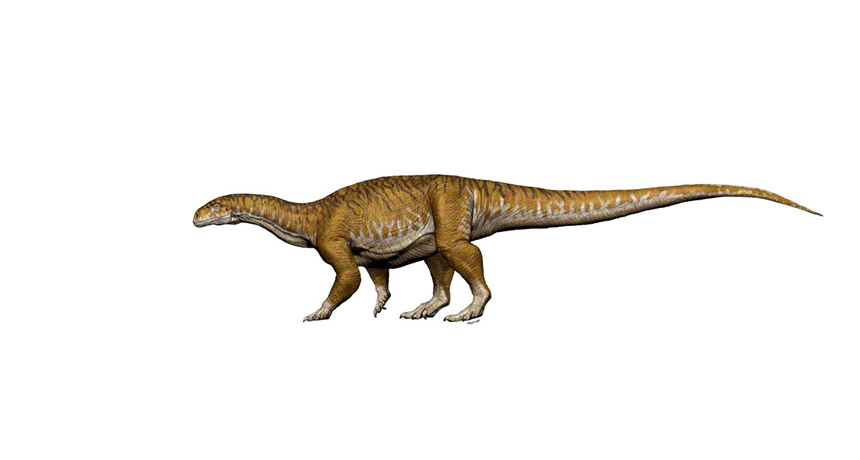There’s more than one way to build a giant dinosaur
Fossils of a new long-necked species break from the expected blueprint for massive bodies

Some early relatives of giant long-necked sauropods may have used an unexpected biological approach to grow to such a large size. This illustration shows how a newly described species, called Ingentia prima, may have looked.
Jorge A. González
Long-necked sauropods (SAHR-oh-pahdz) are the largest animals known to have walked on Earth. These giant plant-eating dinos include Apatosaurus and Brontosaurus. Their early relatives were big, too. Some, though, may have used a different strategy to get their girth, shows a new study.
Most early sauropod relatives shared a common suite of features. They had sturdy, pillarlike legs. They had elongated necks and forelimbs. And their bones grew continuously rather than in seasonal spurts. Scientists had considered this an essential blueprint for massive plant-eaters. But at least some ancient giants may have used a different strategy to get so big. That’s the conclusion of a new fossil analysis of sauropodomorphs (SAHR-oh-PAHD-oh-morfz). That group includes sauropods and some of their similarly shaped relatives.
Cecilia Apaldetti is a paleontologist. She works at the Universidad Nacional de San Juan in Argentina. She and her colleagues examined fossils of four early sauropodomorphs. One belonged to a newly identified species. The team named it Ingentia prima (Ihn-GEHN-tee-uh PREE-muh). The other three were an already known sauropodomorph called Lessemsaurus sauropoides (Lehs-ehm-SAHR-us sahr-uh-POY-deez). These “Lessemsauridae” (Lehs-ehm-SAHR-ih-day) date to the Late Triassic. That’s between 237 million and 201 million years ago. They were smaller than the later sauropods. But they were far from puny. The animals weighed in at an estimated 7 to 10 metric tons. That’s larger than an African elephant!
All four specimens showed a similar set of features. But they didn’t match sauropods and other sauropodomorphs. Instead of upright, pillarlike legs, the dinosaurs had crouched hind limbs. Their front limbs were flexed, with elbows splayed slightly outward. Growth patterns in the fossil bones suggest the animals grew in seasonal spurts rather than steadily. And when their bones grew, they did so unusually fast, Apaldetti says. The growth rate was “even higher than that of the giants that grew continuously.”
These features show there’s more than one way to build a giant dino, her team concludes. It published its findings online July 9 in Nature Ecology and Evolution.
I. prima and L. sauropoides shared some features with later sauropods, though. One was a respiratory system that appears similar to that of birds. The researchers found air sacs within the animals’ vertebrae. These sacs would have held large pockets of oxygen-rich air. They likely helped the dinos keep cool despite their large size. And they made the animals’ vertebrae lighter.
Martin Sander is a vertebrate paleontologist. He works at Universität-Bonn in Germany. He says I. prima presents the best evidence yet of this birdlike respiratory system in sauropodomorphs. Scientists previously weren’t sure. But he isn’t convinced that the Lessemsauridae show a distinct path to massive size. “For me, it’s more of an intermediate stage,” Sander says.
That sentiment is echoed by Jeffrey Wilson. He is a vertebrate paleontologist at the University of Michigan in Ann Arbor. He agrees that Lessemsauridae bone growth was cyclical. But the cycles weren’t necessarily seasonal, Wilson points out. There may have been long growth spurts with fewer lags. That could be a step toward the steady growth seen in sauropods, Wilson says.
The Lessemsauridae lived some 30 million years earlier than Jurassic sauropods, such as Brachiosaurus and Diplodocus. So their growth strategy came first, Apaldetti notes. But ultimately, the Jurassic giants “were more successful,” she says. They outweighed the sauropodomorphs by as much as 60 tons. And they outlived them by tens of millions of years.







